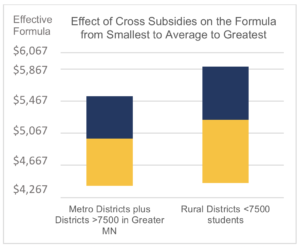Both Minnesota Gov. Mark Dayton and House Ways and Means Chair Jim Knoblach have proposed additional funding for the upcoming school year to address the growing special education cross subsidy.
In FY 2016, the revision of the Minnesota Special Education (SPED) formula rolled out. Despite a significant increase in state SPED funding, the growth in special education expenditures increased 7 percent for FY 2016 and 4.4 percent for FY 2017. They are projected to grow 4.9 percent annually from FY 2017-21. This leads school districts to use general fund formula dollars to ensure education for all students and causes increases in what is known as the cross subsidy.
Cross Subsidy Doubles
Tom Melcher, director of Program Finance for the Minnesota Department of Education (MDE), as part of his presentation on SPED funding to the House Ways and Means Committee shared a graph on the growth of the SPED cross subsidy. Chair Knoblach observed that the cross subsidy has more than doubled than 2003.
Looking back at FY 2017, the last year MDE has preliminary cross subsidy data, the average per pupil cross subsidy was $914. That represents 13.8 percent of the FY 2017 formula of $6,067. Once districts met the SPED needs, on average that left an effective formula of $5,153 for all students.
- How can the SPED formula be increased to cover more SPED costs?
- Is there a way to manage SPED costs as a percent of the formula?
Size Impacts Equity
Looking only at averages obscures the wide range in cross subsidies that create large inequities from district to district. Cross subsidies vary in districts from $172 to$1,654, a range of $1,482. It represents 24 percent of the $6,067 FY 2017 formula. This results in an inequity in the effective formula (formula minus cross subsidy) for students in similar districts.
 MREA conducted research on these inequities and discovered that while the average cross subsidy for Greater Minnesota schools enrolling fewer than 7,500 students was less than the metro average ($835 compared to $1,064),the range in cross subsidies from smallest to largest was wider ($1,444 to $1,116).
MREA conducted research on these inequities and discovered that while the average cross subsidy for Greater Minnesota schools enrolling fewer than 7,500 students was less than the metro average ($835 compared to $1,064),the range in cross subsidies from smallest to largest was wider ($1,444 to $1,116).
As an equity issue, the cross subsidies of school districts creates a wider range of effective formulas in Greater Minnesota than in the metro as can be seen in the graph and table.
EFFECTIVE FORMULA
|
||
| Metro Districts Plus Districts > 7,500 in Greater Minnesota | Rural Districts < 7,500 Students |
|
| Largest | $5,529 | $5,895 |
| Average | $5,003 | $5,232 |
| Smallest | $4,413 | $4,451 |
The districts with greater than average cross subsidies, have smaller effective formulas than districts with less than average cross subsidies.
Greater Minnesota districts with more than 7,500 ADM (Duluth, Elk River, Mankato, Rochester and St. Cloud) are more similar to metropolitan districts than the rest of the rural districts in medical and related services for high need children. These five districts are included what is being called the SPED Equity Metro Region (modified metro).
Two Approaches to Address
Gov. Dayton’s proposal approaches the cross subsidy more as an adequacy issue with a nod to equity and increases nearly all districts SPED aid by improving the formula and lifting the per pupil cap resulting $1 to $30 per pupil increase for nearly all students. View impact by school district.
Rep. Knoblach and Sen. Relph (HF4272/SF3861) approach it as an equity issue and provide aid only to districts above average in cross subsidy in two regions: the SPED Equity Metro Region and Rural Regions with up to $120 per pupil. View impact by school district.
View issue brief on SPED and this approach.
Both proposals call for roughly the same investment. The governor’s proposal requires $16.9 million in 2019, $21.4 million in 2020, and $22.1 million in 2021. The proposal from Knoblach and Relph calls for $20 million per year.
MREA Recommendations
The unfunded SPED costs in FY 2017 were $783 million. That makes $20 million a drop in the bucket in addressing the size of the cross subsidy. Using it effectively in concert with other steps will be important to address the cross subsidy over the next several years.
MREA recommends:
- Enact HF4272/SF3861 to bring school districts with the smallest effective formula closer to the average cross subsidy. This re-insures the formula for districts with above average cross subsidies.
- Establish a Legislative Task Force as outlined in SF3086 to take a serious, comprehensive look at SPED in Minnesota’s regulatory and open enrollment environment.
- Fund a multi-state study with a reputable research organization such as CAREI to see what we can learn from other upper Midwest states and inform the Legislative Task Force.
- Increase the SPED formula to reduce both the average cross subsidy and narrow the range in cross subsidies, and
- Automatically place a surcharge on the formula to maintain the SPED cross subsidy at no more than 10 percent of the formula





